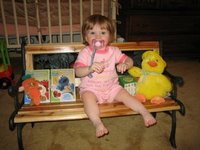More Steps
I should mention that, a couple of weeks back, Lindsey Goins visited Mom all the way from "The Valley" outside of Los Angeles, CA. That's right, Lindsey is a Valley Girl. I believe Lindsey holds the record for person traveling the farthest to visit Mom.
Today was Party Day in Mom's room, and included these visitors:
Gurvis Post
Bradley Cotharn
Kris Cotharn
Austin Cotharn
Kacy Cotharn
Ronda Pippen
Jane Grismer
Jerry Grismer
Bruce Cotharn
Lisa Cotharn
Courtney Cotharn
Baron Cotharn
Greg Cotharn
Vachel Cotharn
In addition to all the visitors, Mom maintained her schedule with these therapies:
- Occupational Therapy: today = dressing and bath activities
- Physical Therapy: today = walking
- Neuro-Psychology: "plays a critical role in planning cognitive rehabilitation activities with the treatment team members."
- Speech Therapy: Mom's actual speech is good. Speech therapy focuses in on areas where Mom has difficulty with cognition: such as short-term memory. Today's session included working with calendars and dates. The therapist would point to significant dates on the calendar. Mom would later try to remember those dates, and why they were significant.
This has been the most fun day of Mom's entire recovery period. She is further along than she has ever been, and she greatly enjoyed all the visitors. Thank you, Nancy Beth and Todd, for scheduling a wedding.














